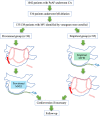The impact of empirical Marshall vein ethanol infusion as a first-choice intraoperative strategy on the long-term outcomes in patients with persistent atrial fibrillation undergoing mitral isthmus ablation
- PMID: 37649670
- PMCID: PMC10464908
- DOI: 10.3389/fcvm.2023.1223064
The impact of empirical Marshall vein ethanol infusion as a first-choice intraoperative strategy on the long-term outcomes in patients with persistent atrial fibrillation undergoing mitral isthmus ablation
Abstract
Background: Marshall vein ethanol infusion (MVEI) as an additional therapy to conventional catheter ablation (CA) has been proved to be efficacious in patients with persistent atrial fibrillation (PeAF). However, whether empirical MVEI could be the first-line strategy in mitral isthmus (MI) ablation has seldom been investigated. Here, we aim to compare the efficacy, safety, and long-term outcomes between provisional and empirical MVEI in PeAF patients undergoing the index MI ablation procedure.
Methods: We enrolled 133 patients with PeAF either in the provisional group (n = 38, MVEI was performed when conventional endocardial and/or epicardial ablation procedures were inadequate to achieve bidirectional MI block) or in the empirical group (n = 95, MVEI was performed empirically before MI CA).
Results: All of the baseline characteristics were comparable. Less spontaneous or inducible atrial tachycardias (ATs) were encountered in the empirical group of patients (P < 0.001). More epicardial ablations were applied (26.3% vs. 9.5%, P = 0.016) and a higher incidence of CA-facilitated restoration of sinus rhythm was recorded (86.8% vs. 11.7%, P < 0.001) in the provisional group of patients. Although more fluoroscopy time (6.4[4.2, 9.3] vs. 9.5[5.9, 11.6] min, P = 0.019) and radiation exposure (69.0[25.3, 160.2] vs. 122.0[62.5, 234.1] mGy, P = 0.010) were documented in the empirical group with comparable procedure time, less time (455.9 ± 192.2 vs. 366.5 ± 161.3 s, P = 0.038) was consumed to achieve bidirectional MI block during endocardial ablation in the provisional group. Incidences of procedure-related complications were similar between the two groups. During a 16.5 ± 4.4-month follow-up, the empirical group of patients showed a significantly higher rate of freedom from AT recurrence (95.8% vs. 81.6%, log-rank P = 0.003), while the rate of freedom from AF or atrial tachyarrhythmias (combining AF and AT) was similar. Both univariate (HR 0.19, 95% CI 0.05-0.64, P = 0.008) and multivariate (HR 0.25, 95% CI 0.07-0.92, P = 0.037) Cox regression analyses indicated that empirical MVEI was independently associated with lower long-term AT recurrence.
Conclusion: Among patients with PeAF who underwent the index MI ablation procedure, empirical MVEI could reduce endocardial MI ablation time and provide greater long-term freedom from AT recurrence.
Keywords: Marshall vein; atrial fibrillation; catheter ablation; ethanol infusion; mitral isthmus.
© 2023 Du, Luo, Shen, Feng, Jin, Fu, Wang, Liu, Gao and Chu.
Conflict of interest statement
The authors declare that the research was conducted in the absence of any commercial or financial relationships that could be construed as a potential conflict of interest.
Figures


Similar articles
-
Acute mitral isthmus block during catheter ablation with vein of Marshall ethanol infusion: Angiographic considerations.Arch Cardiovasc Dis. 2024 Feb;117(2):119-127. doi: 10.1016/j.acvd.2023.11.001. Epub 2023 Nov 19. Arch Cardiovasc Dis. 2024. PMID: 38040560
-
The effect of an initial catheter ablation with an adjunctive ethanol infusion into the vein of Marshall on persistent atrial fibrillation.J Cardiovasc Electrophysiol. 2024 Mar;35(3):453-460. doi: 10.1111/jce.16191. Epub 2024 Jan 28. J Cardiovasc Electrophysiol. 2024. PMID: 38282242
-
Effectiveness of ethanol infusion into the vein of Marshall combined with a fixed anatomical ablation strategy (the "upgraded 2C3L" approach) for catheter ablation of persistent atrial fibrillation.J Cardiovasc Electrophysiol. 2021 Jul;32(7):1849-1856. doi: 10.1111/jce.15108. Epub 2021 Jun 9. J Cardiovasc Electrophysiol. 2021. PMID: 34028114
-
Efficacy and feasibility of vein of Marshall ethanol infusion during persistent atrial fibrillation ablation: A systematic review and meta-analysis.Clin Cardiol. 2024 Jan;47(1):e24178. doi: 10.1002/clc.24178. Epub 2023 Nov 6. Clin Cardiol. 2024. PMID: 37933170 Free PMC article.
-
A proposed index of myocardial staining for vein of Marshall ethanol infusion: an Italian single-center experience.J Interv Card Electrophysiol. 2024 Aug;67(5):1267-1277. doi: 10.1007/s10840-023-01732-4. Epub 2024 Jan 11. J Interv Card Electrophysiol. 2024. PMID: 38206450 Free PMC article. Review.
Cited by
-
Ethanol infusion into the vein of Marshall reduced atrial tachyarrhythmia recurrence during catheter ablation: A systematic review and meta-analysis.Heart Rhythm O2. 2024 Sep 27;5(10):728-738. doi: 10.1016/j.hroo.2024.08.011. eCollection 2024 Oct. Heart Rhythm O2. 2024. PMID: 39524049 Free PMC article.
-
Vein of Marshall Ethanol Infusion for AF Ablation; A Review.J Clin Med. 2024 Apr 22;13(8):2438. doi: 10.3390/jcm13082438. J Clin Med. 2024. PMID: 38673710 Free PMC article. Review.
References
LinkOut - more resources
Full Text Sources

